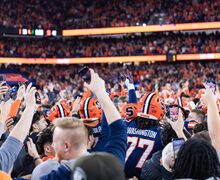His Turn
Lester, a teacher, number-cruncher, disciplinarian takes control of SU attack, shapes untested quarterbacks
Frankie Prijatel | Staff Photographer
Tim Lester will call his first game as a Division I offensive coordinator on Saturday, just a week after being promoted to the position.
Girls in the room drooled a little the first time Tim Lester walked into Barry Brennan’s math class. High cheekbones, tight jawline, brown eyes and all, Lester was about to become their student teacher.
“But he was a taskmaster,” Brennan said. “So they were not going to get away with not doing work.”
Lester was preparing for the 2000 NFL Combine after a record-setting quarterback career at Western Michigan while student-teaching algebra and geometry at Wheaton Warrenville South (Illinois) High School. He didn’t get drafted. He never played a down at any level higher than the XFL or the Arena Football Leagues.
Sternly but patiently, though, he kept teaching and learning. First and briefly, math as a student teacher in actual classrooms. Then on small college football fields around the Midwest.
So on Saturday, a man who both dug trenches for a plumber and secretly slipped algebra and geometry students congratulatory jolly ranchers will sit in a booth above the Carrier Dome turf. Lester, 37, will be calling out plays for a Syracuse (2-3, 0-1 Atlantic Coast) offense he took over from George McDonald a week before facing No. 1 Florida State (5-0, 3-0) at noon on Saturday.
“He just needs an opportunity and this is it,” McDonald said.
The teaching and the pushing are in him as much as his value of controlling the line of scrimmage. His father was his best friend, but his mother was a physical education teacher who made him field extra grounders after poor defensive games of baseball.
Bruising starts are part of his past, too. An 8-year-old Lester came home from his first football practice with black-and-blue arms, upset with the sport. He had begun playing football a year or two later than his teammates and it was a tradition for them to beat up on the new kid. But his parents got him lineman arm pads and Lester immediately became a quarterback.
“After that day when he realized it’s just a little bit of hitting and it’s not going to kill you, he really took to the game,” said his mother, Pat Lester.
He’ll debut as a Division I offensive coordinator without Brisly Estime and potentially Ashton Broyld. He’ll call plays for a battered offensive line and a set of unproven quarterbacks — including freshman AJ Long and sophomores Austin Wilson and Mitch Kimble — that he’s supposed to both develop and contend with.
“You got to game plan differently, you got to understand, you got to communicate with them to figure out what they know and what they don’t know, when they’re lying when they say ‘I got it, Coach,’” Lester said. “… Cause they always say they got it. They never want to say they don’t got it.”
The SU quarterbacks need the Orange to run. They need the rushing game that Syracuse has lacked in all but one of its last three games. Lester needs it too. He just knows it better and more harshly than his quarterbacks.
In his junior year of college, WMU’s starting running back went down injured. Lester still threw for 3,311 yards, but said he struggled to do it. He took a beating along the way, too, losing 0.7 yards per carry himself.
“It’s affected me as a coach ever since,” he said of the experience.
When Division II Saint Joseph’s (Indiana) College hired Lester for his first head coaching job in 2004, Ron Tyner was a redshirt freshman, set to start for the first time in his collegiate career.
As a lineman, he didn’t trust Lester, “this quarterback guy.”
“O-linemen don’t want to go out there and pass block every play so we’re thinking ‘Oh sh*t, here we go, we’ve got a quarterback guy, wants to sling it every down,’” Tyner said. “And he made it very clear that we were going to establish the run and control the line of scrimmage.”
Lester also taught Tyner to stop playing cautiously, Tyner said, while also making him hate disappointing the coach.
A call to Lester was the second one Tyner made after he found out his wife was pregnant and he’ll be in town visiting Lester on Saturday and watching the game. But to this day, after coaching with and befriending the SU offensive coordinator for five years, he’s never called Lester by his first name.
As a coach, Lester speaks publicly almost as freely as he does precisely. Privately, he likes to instruct and mold, simplify and calculate.
“Numbers are good and bad because they can get to the truth and they can also be used to totally fool you,” Lester said.
Lester revels in the late-night silence of his office. There, he grades offenses and quarterbacks, turning most every decision and action they make or take into a statistic.
He keeps his stats on himself, too. Like his record as a head coach in games after days he kicked his team off the practice field. He’s undefeated.
“It really makes no sense,” he said.
Sometimes football lives don’t either. In high school, Lester lived two doors down from a boy named Ronnie Grego in Wheaton, Illinois. They were best friends, who, by their senior years had each played their way to Division I football.
Grego, an all-state linebacker, was set for Northwestern. The quarterback, Lester, was Western Michigan-bound. But encephalitis, a brain-inflaming infection, left Grego disabled. Like Lester, he’s 37 now, but struggles to speak or balance. He can’t drive a car or work and he lives in a group home in Michigan, near where his mother works.
But when Lester was the head coach at Elmhurst from 2008–12, he and Brennan would take Grego out for dinner once a month. They’d go to Chili’s — Grego’s favorite — or Joe’s Crabshack. The meals would sometimes take two hours because Grego also struggles to swallow.
“Even when Tim got bigger and bigger, he hadn’t forgotten people like Ronnie,” Brennan said. “He hadn’t forgotten where he came from.”
Lester shared that hometown with Joe Furco, who Lester eventually started as a true freshman at Elmhurst. Throughout Furco’s career at Elmhurst, Lester also told him that basic execution of a game plan could win football games against any opponents as long as the quarterback kept his offense ticking.
He shared stories of his own playing career with Furco, and called a lot of run plays to ease the freshman’s transition.
But when Furco overslept his alarm and missed a rehab appointment for his ankle, Lester sent a graduate assistant to yank Furco out of his dorm room and ultimately, into a meeting in Lester’s office.
“If you’re going to be a starting quarterback as a freshman, you got to be where you need to be as a leader of the offense,” Furco said Lester told him.
Lester is again preparing an inexperienced quarterback to lead his offense. But this time there are three of them.
He will switch them out, Lester said, but not by quarter or drive. He doesn’t think that’s fair to the quarterbacks or any good for the team. It forces too much pressure on each play and pushes quarterbacks to hold onto the ball too long, he said.
Lester’s been in Long’s position, a true freshman waiting in the wings, knowing he’d only play if the starter was “hurt, hurt.” He admires Wilson’s arm, calling it “special.” Kimble aces every test in the quarterbacks room, but needs to process reads better.
And with all of the Orange’s young quarterbacks, heading toward whatever lessons Florida State teaches, Lester thinks back to his own children.
“I tell my kids all the time, ‘Don’t touch that, it’s hot, don’t touch that,”’ Lester said. “They touch it every time. And then once they touch it, they never touch it again.”
After Tuesday’s practice, Lester said he would go back to his office and cross out about half of his game plan. The Orange didn’t look good enough to run it, he said. As much as he expects the players to simply deal with the decision, he expects them to complain about it.
Said Lester: “But they’ll be happy with me on Saturday.”
Published on October 10, 2014 at 1:39 am
Contact Jacob: jmklinge@syr.edu | @Jacob_Klinger_





